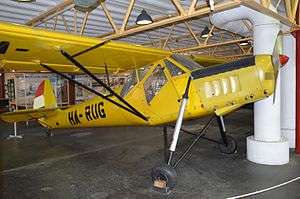Rubik R-18 Kánya
The Rubik R-18 Kánya (English: Kite) is a Hungarian light utility and glider tug aircraft. It was designed by Ernő Rubik, the father of the designer of the Rubik's Cube.
| Rubik R-18 Kánya | |
|---|---|
 | |
| Role | 2-seat glider tug and utility aircraft |
| National origin | Hungary |
| Manufacturer | Aero-Ever |
| Designer | Ernő Rubik |
| First flight | 1948 |
| Number built | 9 |
Design
Ernő Rubik was a co-founder and the chief designer of the Aero-Ever aircraft company of Esztergom, Hungary, which was formed in 1938. He started design of the R-18 in 1944, inspired by the Fieseler Fi 156 Storch, aiming for a smaller, lighter version, which would serve both as a glider tug and a STOL utility aircraft, to carry engineers and spares to service aircraft at other airports.[1]
The aircraft has a high wing braced by V-struts, with fixed leading-edge slots and retractable camber-changing flaps. The fuselage is of mixed construction with two side-by-side seats, with an optional third seat behind them. It has a conventional braced tailplane and a taildragger undercarriage with divided axle long-stroke oleo legs for the main gear, and a fixed tailwheel.[2]
Development
Construction started in 1946, and the first flight of the prototype, the R-18a, c/n E-524, was on 18 May 1949.[3] It was powered by a Walter Major 4-I four-cylinder inline engine of 96.9 kW (129.9 hp) driving a two-bladed wooden propeller. The aircraft was well received, and was used, for a time, by the Hungarian Air Force, registered 1-002, but was soon replaced and transferred to a flying club, registered HA-RUA.
The second aircraft, the R-18b, c/n E-525, registered HA-RUB, had a widened rear fuselage to make the occupant of the third seat more comfortable. It flew from 1949 to 1954 when it crashed.
The third and subsequent aircraft, designated R-18c, c/n E-761, registered HA-RUC, had a Walter Minor 6-III six-cylinder engine of 116 kW (155 hp), which extended the fuselage length to 7.7 m (25 ft). The cabin windows and doors were slightly redesigned, and the third seat was replaced by a 120 l (32 US gal; 26 imp gal) fuel tank. Because of problems with the Walter Minor in-line engines, all surviving R-18s were converted to licence-built Shvetsov M-11D five-cylinder radial engines of 93.2 kW (125.0 hp),[1] or M-11FR engines of 119 kW (160 hp)[4] leading to a reduced fuselage length of 7.5 m (25 ft).[5] The conversion work was done by the Central Experimental Plant at Alag, between 1955 and 1958.[6]
Construction of a metal version, the R-28 Metal-Kanya, was started but was not completed.
Operational history
The first three aircraft were considered prototypes, and they were followed by six production aircraft, all designated R-18c and built in 1953-54. They were registered HA-RUD to HA-RUI. One aircraft was fitted with skis for winter use. They continued in use until 1966 by which time all aircraft except two had crashed and/or been scrapped or withdrawn from use.
The R-18a crashed in 1949 and was subsequently used as an instructional airframe.
Survivors

Two aircraft survive:
- HA-RUF, c/n E-778, was withdrawn from use in 1966 but was restored to flying condition in 2012 by the Goldtimer Foundation, and is based at Budaörs Airport, Budapest.[5]
- HA-RUG, c/n E-779, was withdrawn from use in 1966, and was placed on display in the Hungarian Technical and Transportation Museum in Budapest,[7] but the building was demolished in 2016 and the current status of the aircraft is unknown.
Specifications (R-18a)
Data from Janes All the World's Aircraft 1953-54[2]
General characteristics
- Crew: 2
- Length: 7.7 m (25 ft 3 in)
- Wingspan: 11.6 m (38 ft 1 in)
- Height: 2.08 m (6 ft 10 in)
- Wing area: 14 m2 (150 sq ft)
- Empty weight: 410 kg (904 lb)
- Gross weight: 690 kg (1,521 lb)
- Powerplant: 1 × Walter Minor 4-I 4-cylinder inverted air-cooled in-line piston engine, 119 kW (160 hp)
Performance
- Maximum speed: 175 km/h (109 mph, 94 kn)
- Range: 600 km (370 mi, 320 nmi)
- Service ceiling: 6,000 m (20,000 ft)
- Rate of climb: 300 m/s (59,000 ft/min)
References
- "Rubik Erno". Retrieved 2017-04-08.
- Bridgman, Leonard (1954). Jane's All The World's Aircraft 1953-54. Jane's All The World's Aircraft Publishing Company. p. 156.
- Simpson, R.W. (1995). Airlife's General Aviation (2nd ed.). Shrewsbury, UK: Airlife Publishing. p. 218. ISBN 1 85310 577 5.
- Green, William; Pollinger, Gerald (1965). The Aircraft of the World (Third ed.). London: Macdonald & Co (Publishers). p. 80.
- "Goldtimer Foundation R-18 Kanya". Goldtimer Foundation. Retrieved 2017-04-08.
- "Hungarian Gliders 1933-2000". Retrieved 2017-04-08.
- "ABPic Photo Library". Retrieved 2017-04-08.